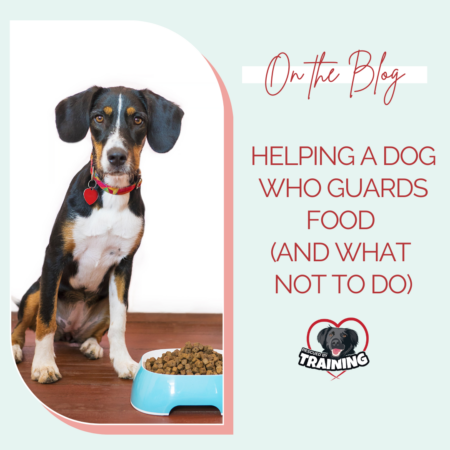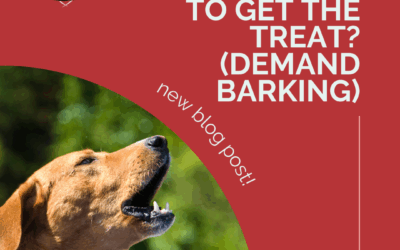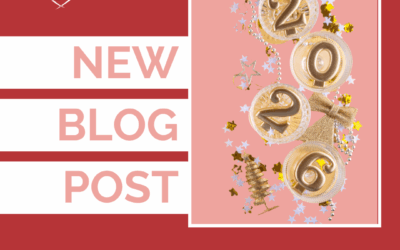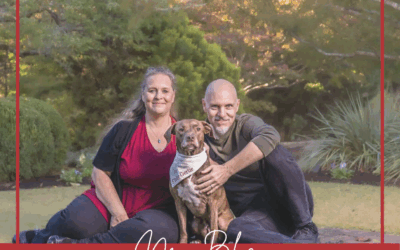If your dog growls, freezes, eats faster or tries to bite if you approach him when he’s eating, then it’s possible he’s guarding his food. Food guarding is a completely normal and very common dog behavior but it understandably upsets owners and in some cases, can be a safety concern, especially if there are children in the home. If you have a puppy or a new dog who doesn’t resource guard, now is the time to help teach them that people approaching is good, not threatening. You can see that post and videos here.
Even if you have a dog who is food guarding, the good news is we can help dogs feel better and even like when we approach them and they have food. It’s not about showing the dog who is the boss or showing him that you “control” the food. The best way to help modify food guarding is teaching the dog that you approaching predicts good stuff is about to happen, not that anything scary is about to happen.
This may surprise you, but food guarders are afraid, not being dominant or bossy or any of those other silly claims. They’re afraid of losing their valuable resource – their food. When working with any dog who is fearful or upset, it’s incredibly important that we pay attention to body language to know how they’re feeling in that moment because this can change second to second. Some dogs are very subtle when they’re upset. They may only tense up or give a little lip lick. Some dogs freeze or eat faster (thinking something like “I’d better hurry up and finish this before she takes it away!”)
Other dogs are much more obvious and growl, lip curl or try to bite. And even though all dogs speak through body language, not every dog does the same sequence of threat signals so it’s important to learn your dog’s dialect of body language so you know what they’re saying. Grab my download on dog communication here.
Resource guarding can be scary and dangerous but it’s important to remember, guarding in dogs is a completely normal behavior. It doesn’t make your dog a“bad dog” and dogs should never be punished or scolded for growling or otherwise communicating when they’re upset we’re trying to take something they find valuable.
As my mentor, Jean Donaldson says in her book about resource guarding, Mine,
“Guarding food, objects, mates and spaces are highly adaptable traits in a natural environment. If dogs had to fend for themselves tomorrow, guarders would have the survival and reproductive edge over non-guarders.”
The internet, and well-meaning friends, may have lots of suggestions on what to do but often those suggestions not only don’t help but can actually contribute to or cause resource guarding!
Here are the common suggestions that may actually cause more harm than good. In other words, here’s what NOT to do:
Myth #1: Touch your dog while he’s eating, to show him you don’t mean any harm.
Reality: No, don’t touch/pet your dog while he’s eating. Let him eat in peace. Do you want someone poking at you or petting your head while you’re trying to eat? (I doubt it.) Leave your dog alone when they’re eating/chewing on something valuable or resting.
Myth #2: Take away his food bowl while he’s eating and then give it back to him.
Reality: No, don’t take away his food bowl while he’s eating. The only thing that might be accomplished here is your dog learning that when you approach him, you interrupt his eating and take away his food bowl, which could lead to him guarding it in the future.
Myth #3: Stick your hand in the bowl while he’s eating.
Reality: Nope, please don’t do that. Not only could you get bit but there’s nothing to be gained by doing this. Would you want someone sticking their hand in your food when you’re eating? Probably not and you might stab them with your fork.
Myth #4: Feed your dog in a high traffic/busy area so he gets used to people walking by when he’s eating.
Reality: Again, nope. This won’t teach your dog to get used it anything and could just create a situation where he’s on edge when he’s eating or begins to guard if he feels unsafe eating in such a busy area.
Myth #5: Make resources abundant so he’ll learn he doesn’t have to guard.
Reality: Unfortunately, it just doesn’t work like that. Deprivation sometimes can contribute to guarding but undoing that learning needs to be active, not passive. It’s unlikely the dog will come to conclusion, “hey, wait a minute – I have lots of other toys – I don’t need to guard this one!”
Myth #6: Your dog is guarding because he’s dominant or a “bad” dog. You need to be the boss/alpha.
Reality: Nope again. Your dog is guarding because those items are valuable to him and his doggy software is telling him to protect these things because his life depends on it. We know it doesn’t but the software in domestic dogs can be a little buggy, so his brain is telling him otherwise. It’s got nothing to do with alpha or being the boss or being dominant. All of these ideas are outdated or debunked ideologies of training, even though they’re still pretty prevalent in culture. Doing any sort of aversive, rough handling like pinning or scolding him if he’s guarding will only make things worse. You can read my blog about that here.
Guarding is a normal behavior. Guarding doesn’t mean your dog is a bad dog or that there is anything wrong with him.
What can you do?
Make sure your dog feels safe in their eating location, aren’t being bothered and if you need to go near them, toss a super high value bonus food in their bowl or near them. Don’t ask them to sit or look at you or do anything – just toss something better than what’s in their bowl, even from a far distance. This will start to lay a foundation that you being around them while they are eating means something good happens, not any of the things I list above. You’re not there to mess with them, take their food away, touch them or their food, harass them…you’re just passing by to give them an upgrade.
Of course the specific details of exactly the process for doing a systematic training plan needs to be reviewed one-on-one so if you have a guarder, whether it’s food, toys, location, favorite person or high value chews, reach out to me for help. You may also be interested in my other blog posts How To Help A Dog Who Guards Bully Sticks and How To Help A Dog Who Food Guards. Resource guarding is one of the most common behavior issues I help with, all remotely. I don’t need to see your dog growling to help you and him so it doesn’t matter where you are in world – I can help you!
Happy training!
![]()




